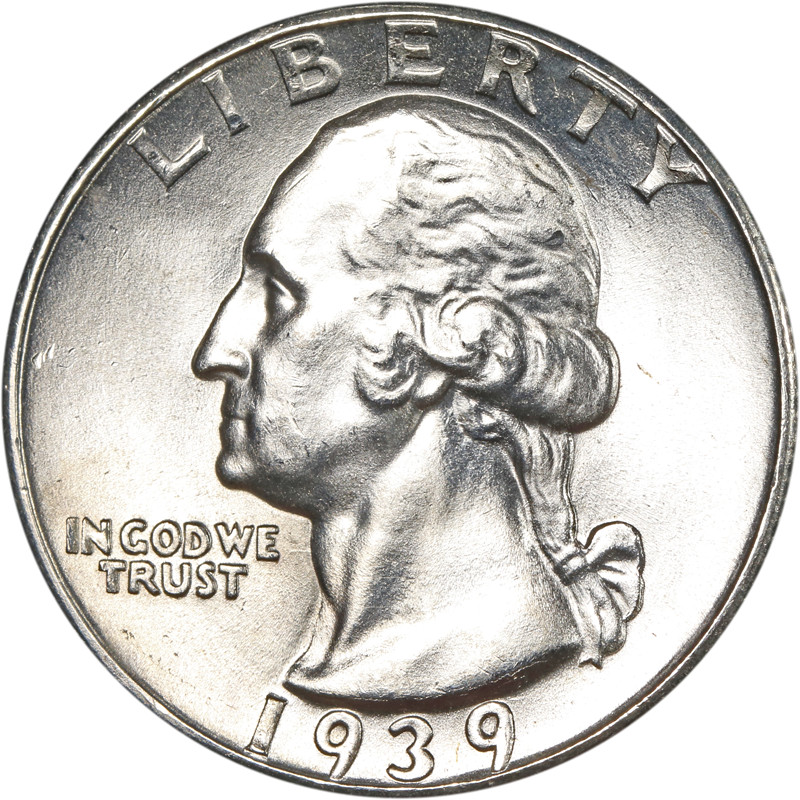The 1939 Washington Quarter stands as an important piece in the history of American coinage. As part of the popular Washington Quarter series, these coins were produced before the transition to clad composition in 1965, maintaining a 90% silver content. This article explores the key facts, historical background, mintage figures, design details, error coins, and current market values of the 1939 Washington Quarter. Whether you are a collector, investor, or simply interested in U.S. coins, this guide provides accurate and up-to-date information on this classic silver quarter.

Key Highlights
- Designer: John Flanagan
- Composition: 90% Silver, 10% Copper
- Mints: Philadelphia (no mint mark), Denver (D), San Francisco (S)
- Silver Weight: 0.1808 troy ounces
- Notable Errors: Doubled die obverses, repunched mint marks
- Highest Auction Price: Over $17,000 for an MS68+ graded coin
Who Designed the 1939 Washington Quarter? Interesting Facts about the Series
The Washington Quarter was designed by John Flanagan, a renowned American sculptor. The series was introduced in 1932 to commemorate the 200th anniversary of George Washington’s birth. Flanagan’s design was chosen for its classic depiction of Washington, which has become a mainstay of American coinage.
An interesting fact about the series is that the original design remained largely unchanged for over five decades. The quarter’s production in 1939 carried forward the traditional look and silver composition that is highly regarded among collectors today.
Obverse and Reverse Design of the 1939 Washington Quarter
The obverse of the 1939 Washington Quarter features a left-facing portrait of George Washington, with the word “LIBERTY” above and the date “1939” below. The motto “IN GOD WE TRUST” appears to the left of Washington’s neck.
The reverse shows an eagle with outstretched wings perched on a bundle of arrows above two olive branches. The inscriptions “UNITED STATES OF AMERICA” and “QUARTER DOLLAR” appear above and below the eagle, with “E PLURIBUS UNUM” between the eagle’s wings.
Mints and Mintage Figures for the 1939 Washington Quarter
The 1939 Washington Quarter was struck at three U.S. Mint facilities:
- Philadelphia Mint (no mint mark)
- Denver Mint (D)
- San Francisco Mint (S)
Mintage numbers for each mint in 1939:
- Philadelphia (no mint mark): 33,540,000
- Denver (D): 7,092,000
- San Francisco (S): 4,836,000
No proof coins were struck in 1939, as proof production resumed only in 1936 and was suspended during World War II after 1942.
Are There Any Notably Rare 1939 Washington Quarters?
The 1939-S Washington Quarter has the lowest mintage of the year, making it less common in higher grades. However, none of the regular-issue 1939 quarters are considered major rarities in circulated condition. In uncirculated and high Mint State grades (MS67 and above), coins from all three mints become much scarcer and more valuable.
The most valuable 1939 Washington Quarters are those that are graded MS68 or higher, especially with original luster and strong eye appeal. These top-graded coins have set auction records.
- 1939-S MS68: Sold for $17,625 at auction in 2013 (Heritage Auctions)
- 1939-D MS68: Similar high prices for MS68 or “plus” examples
Notable Error Coins from the 1939 Washington Quarter
Error coins add an extra layer of interest for collectors. Some notable errors for the 1939 Washington Quarter include:
- Doubled die obverse (DDO)
- Repunched mint marks (RPM) on Denver and San Francisco issues
- Off-center strikes and clipped planchets (less common, but occasionally found)
Below is a table summarizing notable 1939 error quarters and their approximate value ranges based on recent auction results:
| Mint Mark | Error Type | Description | Value Range (USD) |
|---|---|---|---|
| No Mintmark (Philadelphia) | Doubled Die Obverse (DDO) | Noticeable doubling on date and motto | $100 – $500+ |
| D (Denver) | Repunched Mint Mark (RPM) | Secondary “D” visible under or above main mintmark | $75 – $350 |
| S (San Francisco) | Off-Center Strike | Design partially missing due to off-center strike | $150 – $600 |
| Any | Clipped Planchet | Portion of the coin is missing from a mis-cut planchet | $75 – $250 |
Value Range for the 1939 Washington Quarter by Mint and Condition
The value of a 1939 Washington Quarter depends on its mint mark and condition. The following table presents typical value ranges as of 2024:
| Mint | Good (G4) | Very Fine (VF20) | Extremely Fine (EF40) | About Uncirculated (AU50) | MS60 | MS65 | MS67 | MS68 |
|---|---|---|---|---|---|---|---|---|
| Philadelphia (no mint mark) | $6 | $7 | $8 | $12 | $18 | $55 | $400 | $3500+ |
| Denver (D) | $6 | $8 | $10 | $18 | $30 | $80 | $700 | $4500+ |
| San Francisco (S) | $7 | $10 | $14 | $22 | $45 | $150 | $1100 | $6000+ |
Note: Values reflect retail prices for certified coins, with premiums for strong luster, eye appeal, and top population grades. Raw coins (ungraded) typically trade at the lower end of each range.
Does the 1939 Washington Quarter Have Intrinsic Value?
Yes, the 1939 Washington Quarter is made of 90% silver, giving it intrinsic value based on its precious metal content. As of mid-2024, the melt value (based on silver spot price) is approximately $4–$5 per coin, with collectible value generally exceeding melt value for most examples, especially in higher grades.
Conclusion
The 1939 Washington Quarter remains a popular choice for both collectors and investors due to its classic design, silver content, and availability in higher grades. While common in circulated condition, high-quality mint state coins and notable errors can command significant premiums. With steady demand and intrinsic value, the 1939 Washington Quarter continues to be a staple in U.S. coin collections and a sound option for those interested in silver investment.